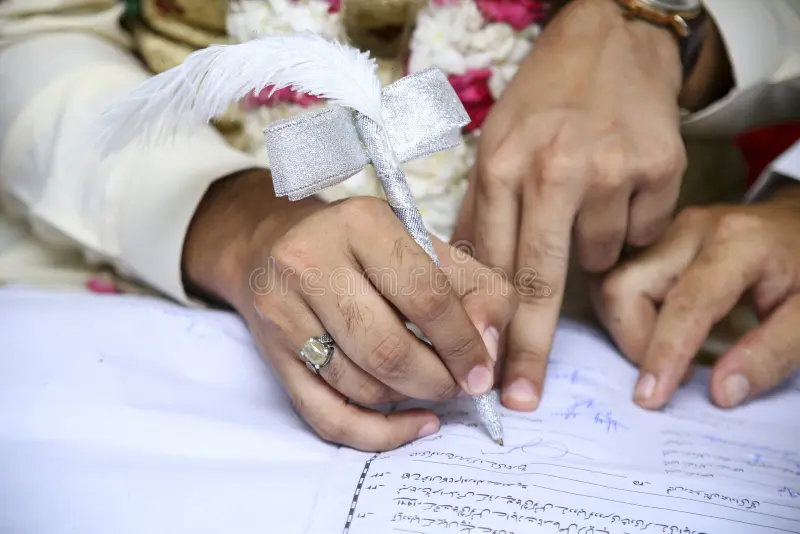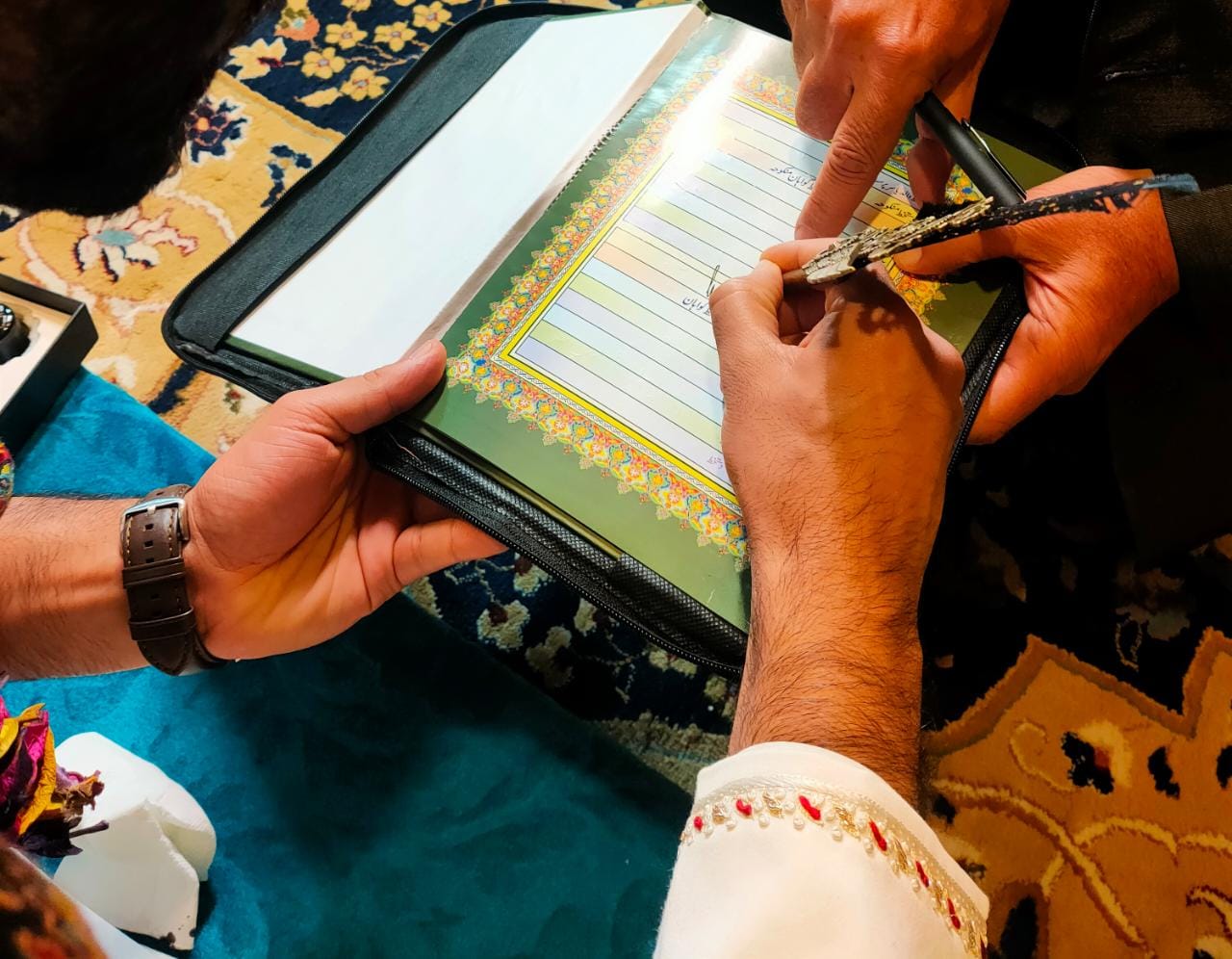Nikah Is a Private Affair, Not a Public Spectacle: Mirwaiz Umar Farooq
By: Javid Amin | 25 September 2025
The Call From the Pulpit
In Srinagar’s historic Jamia Masjid, the voice of Mirwaiz Umar Farooq echoed across the courtyard:
“Nikah is a sacred contract between two souls. It is meant to be solemn, spiritual, and modest — not a spectacle of extravagance.”
For centuries, weddings in Kashmir were intimate affairs. Families gathered to pray, elders blessed the couple, and the celebrations were modest, rooted in culture and community. Today, Mirwaiz’s words strike a stark contrast against a new reality: a Valley where weddings are curated for cameras, brides are showcased on Instagram, and the essence of marriage is measured in likes rather than blessings.
From Tradition to Transaction
The Old Kashmir Wedding
Two decades ago, Kashmiri weddings were simple yet profound. The Nikah would occur at home or in a small mosque, surrounded by close family. Daughters were escorted with love, not pomp. The wanwun — traditional songs sung by women — echoed in courtyards, blessing the bride and groom. Wazwan meals were served modestly, and celebrations emphasized unity and faith over grandeur.
The Modern Spectacle
Today, weddings resemble performances:
-
Drone shots hover over banquet halls.
-
Brides pose in designer lehengas for cinematic reels.
-
Hashtags like #KashmirWedding trend globally.
-
Imported décor and live performances overshadow local customs.
Where once the Nikah’s sanctity was protected by walls and whispers, today it is broadcast to thousands, often with little regard for privacy or dignity.
The Social Media Validation Culture
Social media has not merely documented Kashmir weddings; it has redefined them. Platforms like Instagram and TikTok have created a culture where weddings are judged by popularity, engagement, and viral potential.
-
Hashtags and likes have replaced blessings.
-
Family honor is increasingly tied to “view counts.”
-
Cultural rituals are sidelined for cinematic effect.
Daughters on Display
The human cost is acute. Kashmiri brides, historically symbols of modesty and respect, are now paraded online.
-
Dupattas are adjusted in slow motion for reels.
-
Bridal henna and outfits are consumed by strangers.
-
Private prayers and family moments are cropped into viral content.
This commodification of daughters erodes both cultural dignity and spiritual values.
Case Study: The Instagram Marriage
Rameez and Hina from Baramulla exemplify the trend. Their wedding video, shot by a professional cinematographer, went viral on Instagram. Drone footage, designer outfits, and slow-motion shots earned thousands of likes.
But reality was harsher:
-
Families were buried under financial strain.
-
Post-wedding conflicts emerged over debts.
-
Gossip and speculation on social media intensified marital stress.
“It was never about us,” Hina later admitted. “It was about performing for the world. We forgot marriage is about living, not filming.”
Their story is far from isolated. Many young couples begin married life under the crushing weight of expectations set by social media performance.
Debt, Dowry, and Delayed Marriages
The Debt Epidemic
Lavish weddings come at a cost. In Srinagar’s outskirts, small orchard owners like Farooq Ahmad borrowed over ₹12 lakh for their daughters’ nuptials. The grand wedding earned praise for days, but post-celebration, debts lingered, forcing Farooq to sell half his orchard.
Dowry Disguised as Tradition
Despite Islamic injunctions, dowry persists under the guise of “customary gifts.” Families demand gold, furniture, cars — sometimes entire property transfers. Those who cannot comply see their daughters remain unmarried, sometimes into their 30s, facing societal stigma.
Case Study: The Bride with No Gold
Shazia, 26, could not marry because her family couldn’t meet her suitor’s extravagant demands.
“I spent my life teaching honesty and faith. Yet I could not give my daughter away with dignity because I had no money for gold,” said her father.
Shazia now works as a tutor, waiting for a match where her value is measured by character, not possessions.
Delayed Marriages
The obsession with spectacle delays marriage for many. Men migrate to earn more; families postpone weddings; daughters wait. This delay contributes to frustration, social pressure, and a rise in immorality among youth.
Cultural Erosion
The consequences go beyond finance. Kashmiri weddings now prioritize performance over prayer, aesthetics over ethics, reels over rituals.
-
Wanwun and folk songs are replaced with Bollywood playlists.
-
Community kitchens disappear, replaced by private caterers.
-
Family blessings are secondary to likes and comments.
Even rituals like the Nikah khutbah are drowned in the noise of videographers directing shots. The culture of intimate, spiritual family gatherings is being replaced with digital theater.
Emotional and Social Costs
Domestic Strain
Couples entering marriage under financial and social pressure often experience tension, leading to disputes and, in some cases, separation.
Parents’ Burden
Parents expend life savings to fund public displays. Elderly guardians watch as their sacrifices are consumed by performance culture, leaving them emotionally and financially drained.
Societal Fracture
Communities now measure marriage success by spectacle rather than happiness, eroding traditional values of modesty, respect, and family cohesion.
Faith as a Corrective Lens
Islamic tradition promotes simplicity and spiritual grounding in marriage:
“The most blessed Nikah is the one with the least expenditure.” — Prophet Muhammad (PBUH)
Kashmiri culture once reflected this. Modest weddings, small gatherings, and heartfelt prayers were central. The current trend inverts this ethos, prioritizing status and spectacle over faith and family.
The Way Forward
01. Community Initiatives
-
Mosques can host campaigns promoting simple, meaningful Nikah ceremonies.
-
Village elders can establish community guidelines capping wedding expenses and guest lists.
-
Religious leaders must consistently reinforce messages on modesty and spiritual focus.
02. Digital Awareness
-
Educate youth and families about the psychological and cultural risks of social media validation.
-
Encourage privacy and protect daughters from unnecessary exposure.
03. Legal Safeguards
-
Enforce anti-dowry legislation.
-
Monitor property transfers and prevent coercive demands.
-
Subsidize public halls promoting modest, low-cost weddings.
04. Reviving Cultural Roots
-
Reintroduce wanwun, rouf, and sufiyana practices.
-
Celebrate traditional attire and local cuisine over imported glamour.
-
Use community storytelling to transmit values of simplicity and faith.
Closing Reflection
Kashmir has survived conflict, displacement, and socio-economic upheaval. Yet the slow erosion of cultural and spiritual values through lavish, social media-driven weddings poses a subtler but equally devastating threat.
Nikah is not a performance, nor a content generator. It is a covenant of love, trust, and faith.
Let Kashmir reclaim its daughters, its traditions, and its ceremonies from the clutches of algorithms and hashtags. Let marriages echo with blessings, not likes. Let the Valley remember that true wealth is measured not in gold and reels, but in prayer, respect, and togetherness.
Because in the end, a wedding is not for the world to see. It is for two souls to live, and a family to cherish.


